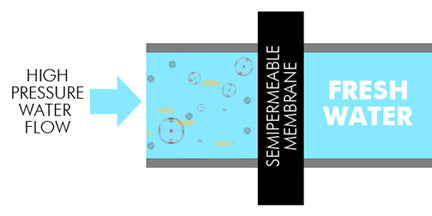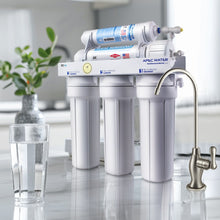Reverse osmosis (RO) is the most economical method of removing 90% to 99% of all contaminants. The pore structure of RO membranes is much tighter than UF membranes. RO membranes are capable of rejecting practically all particles, bacteria and organics >300 daltons molecular weight (including pyrogens). In fact, reverse osmosis technology is used by most leading water bottling plants.
Natural osmosis occurs when solutions with two different concentrations are separated by a semi-permeable membrane. Osmotic pressure drives water through the membrane; the water dilutes the more concentrated solution; and the end result is an equilibrium.

In water purification systems, hydraulic pressure is applied to the concentrated solution to counteract the osmotic pressure. Pure water is driven from the concentrated solution and collected downstream of the membrane.
Because RO membranes are very restrictive, they yield slow flow rates. Storage tanks are required to produce an adequate volume in a reasonable amount of time.
RO also involves an ionic exclusion process. Only solvent is allowed to pass through the semi-permeable RO membrane, while virtually all ions and dissolved molecules are retained (including salts and sugars). The semi-permeable membrane rejects salts (ions) by a charge phenomena action: the greater the charge, the greater the rejection. Therefore, the membrane rejects nearly all (>99%) strongly ionized polyvalent ions but only 95% of the weakly ionized monovalent ions like sodium.
Reverse osmosis is highly effective in removing several impurities from water such as total dissolved solids (TDS), turbidity, asbestos, lead and other toxic heavy metals, radium, and many dissolved organics. The process will also remove chlorinated pesticides and most heavier-weight VOCs. Reverse osmosis and activated carbon filtration are complementary processes. Combining them results in the most effective treatment against the broadest range of water impurities and contaminants.
RO is the most economical and efficient method for purifying tap water if the system is properly designed for the feed water conditions and the intended use of the product water. RO is also the optimum pretreatment for reagent-grade water polishing systems.
In addition, Reverse osmosis treatment is an insurance policy against nuclear radiation such as radioactive plutonium or strontium in the drinking water. If one lives near a nuclear power plant, this is a key way to ensure the household is drinking the best water for their health.
|
|||||||



